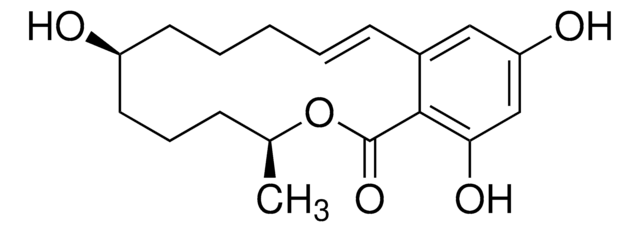Kluczowe dokumenty
CRM16869
Diquat metabolite Monopyridone
certified reference material, TraceCERT®, Manufactured by: Sigma-Aldrich Production GmbH, Switzerland
Synonim(y):
1-Oxo-9,10-dihydro-1H-10a-aza-8a-azoniaphenanthrene chloride, 6,7-Dihydro-9-oxo-9H-dipyrido[1,2-a:2′,1′-c]pyrazin-5-ium chloride
About This Item
Polecane produkty
klasa czystości
certified reference material
TraceCERT®
Poziom jakości
linia produktu
TraceCERT®
okres trwałości
limited shelf life, expiry date on the label
producent / nazwa handlowa
Manufactured by: Sigma-Aldrich Production GmbH, Switzerland
Format
neat
temp. przechowywania
2-8°C
ciąg SMILES
O=C1N2CC[N+]3=CC=CC=C3C2=CC=C1.[Cl-]
InChI
1S/C12H11N2O.ClH/c15-12-6-3-5-11-10-4-1-2-7-13(10)8-9-14(11)12;/h1-7H,8-9H2;1H/q+1;/p-1
Klucz InChI
FYUAZDQCXQJCPZ-UHFFFAOYSA-M
Szukasz podobnych produktów? Odwiedź Przewodnik dotyczący porównywania produktów
Powiązane kategorie
Opis ogólny
Certyfikowana zawartość za pomocą ilościowego NMR wraz z niepewnością i datą ważności są podane na certyfikacie.
Pobierz certyfikat na stronie: http://www.sigma-aldrich.com
Monopirydon dikwatu jest powszechnym produktem degradacji dikwatu. Dikwat jest nieselektywnym, defoliantem, herbicydem przed żniwami i osuszaczem, który należy do klasy bipirydyn. Dikwat może szybko przenikać przez powierzchnię liści, ale nie jest pobierany przez korzenie ze względu na silną adsorpcję na cząstkach gleby. Jego działanie opiera się na uwalnianiu anionorodnika ponadtlenkowego, a następnie nadtlenku wodoru, powodując zniszczenie tkanki przez stres oksydacyjny. Działanie chwastobójcze dikwatu jest bardziej wyraźne w świetle dziennym, warunkach tlenowych, wysokiej wilgotności i temperaturze.
Dikwat nie jest zatwierdzony do stosowania w Unii Europejskiej. Maksymalny limit pozostałości (MRL) dla obecności dikwatu w uprawach waha się od 0,05 mg/kg w większości towarów do 10 mg/kg dla siemienia lnianego i jęczmienia.
Definicje pozostałości w UE są szersze, jednak nadal brakuje danych toksykologicznych dla metabolitów dikwatu, monopirydonu i dipirydonu, aby porównać ich toksyczność ze związkiem macierzystym.
Zastosowanie
- Wykrywanie dwóch metabolitów dikwatu w moczu i surowicy zatrutych pacjentów po spożyciu połączonych herbicydów, parakwatu i dikwatu.
- Analiza parakwatu, dikwatu i dwóch metabolitów dikwatu w materiałach biologicznych za pomocą wysokosprawnej chromatografii cieczowej sprzężonej z detektorami UV i fluorescencji.
Informacje prawne
Hasło ostrzegawcze
Danger
Zwroty wskazujące rodzaj zagrożenia
Zwroty wskazujące środki ostrożności
Klasyfikacja zagrożeń
Acute Tox. 2 Inhalation - Acute Tox. 3 Dermal - Acute Tox. 3 Oral - Aquatic Acute 1 - Aquatic Chronic 1 - Eye Irrit. 2 - Skin Irrit. 2 - Skin Sens. 1 - STOT RE 1 Oral - STOT SE 3
Organy docelowe
Respiratory system
Kod klasy składowania
6.1A - Combustible acute toxic Cat. 1 and 2 / very toxic hazardous materials
Klasa zagrożenia wodnego (WGK)
WGK 2
Temperatura zapłonu (°F)
Not applicable
Temperatura zapłonu (°C)
Not applicable
Wybierz jedną z najnowszych wersji:
Certyfikaty analizy (CoA)
It looks like we've run into a problem, but you can still download Certificates of Analysis from our Dokumenty section.
Proszę o kontakt, jeśli potrzebna jest pomoc Obsługa Klienta
Masz już ten produkt?
Dokumenty związane z niedawno zakupionymi produktami zostały zamieszczone w Bibliotece dokumentów.
Nasz zespół naukowców ma doświadczenie we wszystkich obszarach badań, w tym w naukach przyrodniczych, materiałoznawstwie, syntezie chemicznej, chromatografii, analityce i wielu innych dziedzinach.
Skontaktuj się z zespołem ds. pomocy technicznej
![[Des-Tyr22]-Calcitonin salmon](/deepweb/assets/sigmaaldrich/product/images/282/634/15345f68-95be-4b5f-abc2-cb170099f26f/640/15345f68-95be-4b5f-abc2-cb170099f26f.jpg)





